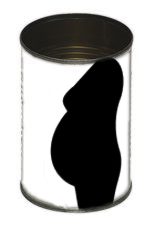For those of us in the building industry, don't think that BPA isn't a concern just because you only seem to hear about it in plastic bottles and dental night guards. When researching concrete sealants for slabs with moisture problems I discovered that the product most highly recommended was 40-60% BPA. My recommendation is to ask for MSDS from any sealant manufacturer before specifying a sealant product. Am sure BPA is also found in many other building products.
Blog Post
Wanted by Chemical Industry: Young, Pregnant Spokesperson for Bisphenol-A

Over the past decade, a growing body of scientific studies has linked the chemical to breast cancer, testicular cancer, diabetes, hyperactivity, obesity, low sperm count, miscarriage and other reproductive problems in laboratory animals. More recent studies using human data have linked BPA to heart disease and diabetes. And it has been found to interfere with the effects of chemotherapy in breast cancer patients. Researchers have found that BPA leaches from containers into food and beverages, even at cold temperatures. A study by the Harvard School of Public Health published earlier this month found that subjects who drank liquids from plastic bottles containing BPA had a 69 percent increase in the BPA in their urine. Despite more than 100 published studies by government scientists and university laboratories that have raised health concerns about the chemical, the Food and Drug Administration has deemed it safe largely because of two studies, both funded by a chemical industry trade group.
It's evidently this sort of reporting that frustrates the embattled pro-BPA faction so much that one suggested response during the meeting was to find a "'holy grail' spokesperson" — a "pregnant young mother who would be willing to speak around the country about the benefits of BPA." The minutes go on to state that "the committee doubts obtaining a scientific spokesperson is attainable."
- Milwaukee Journal-Sentinal: BPA industry seeks to polish image
- Washington Post: Strategy Being Devised To Protect Use of BPA
- NAMPA press release
ScienceBlogs has posted what is apparently the full text of the leaked minutes. For the pro-BPA industry's take, see bisphenol-a.org, presented by the American Chemistry Council (which "represents the companies that make the products that make modern life possible"), PlasticsEurope ("an association of plastics manufacturers that deals with complex legislative processes"), and the Japan Chemical Industry Association ("promoting the stable development of the chemical industry").
Published June 1, 2009 Permalink Citation
(2009, June 1). Wanted by Chemical Industry: Young, Pregnant Spokesperson for Bisphenol-A. Retrieved from https://www.buildinggreen.com/news-article/wanted-chemical-industry-young-pregnant-spokesperson-bisphenol
Comments
Jan, you're absolutely right.
Jan, you're absolutely right. As noted in the post, most BPA is used for polycarbonate plastic and epoxy resins - both of which are in heavy use in the building industry.
The Committee on Energy and C
The Committee on Energy and Commerce and its Subcommittee on Oversight and Investigations has requested NAMPA's chair to supply "1. All documents and communications, including talking points, minutes, summaries, memoranda, media statements, e-mails, and drafts of any such documents, relating to meetings of the BPA Joint Trade Association in April and May 2009, including documents and communications created by the date of this request; 2. A list of all attendees at these meetings, including their affiliations and contact information; and 3. A list of all members of the BPA Joint Trade Association, including their contact information." See http://media.journalinteractive.com/documents/waxman-stupak_060209.pdf



Add new comment
To post a comment, you need to register for a BuildingGreen Basic membership (free) or login to your existing profile.